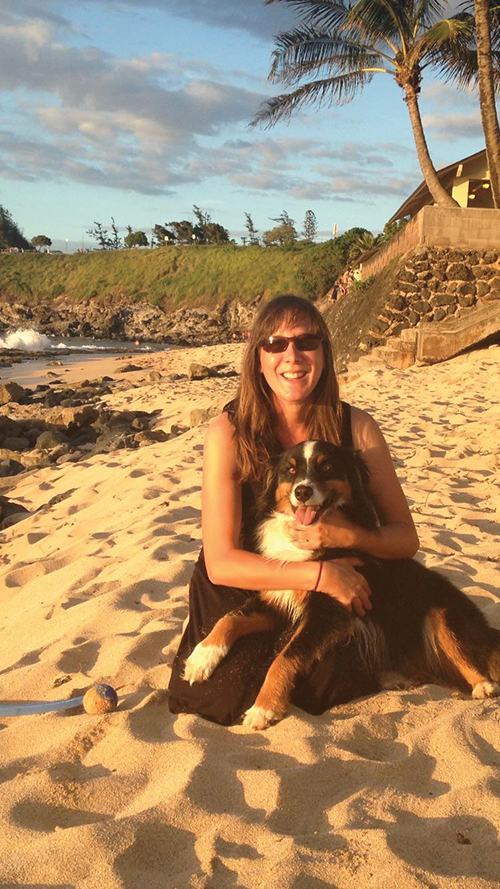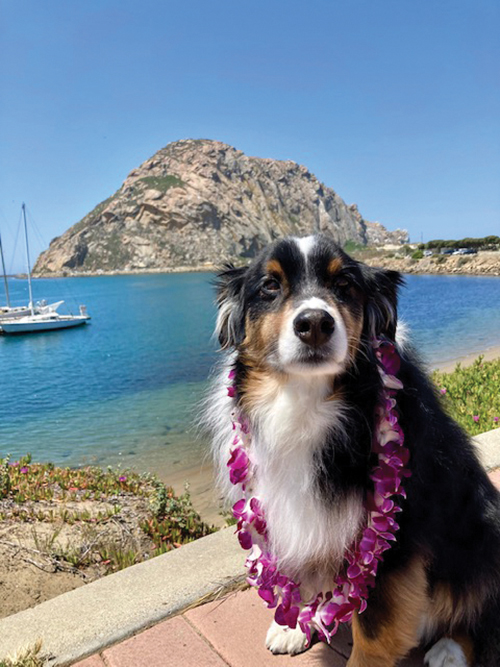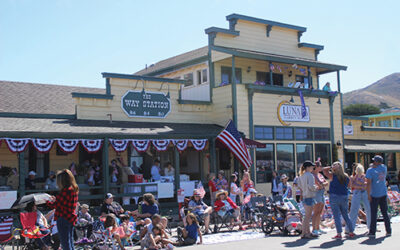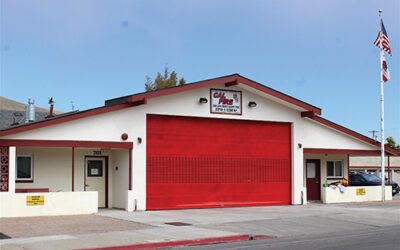Moosh, the therapy dog, poses with Morro Rock in the background after spending time running on the beach. Photo submitted
Comfort and companionship can come in many forms — sometimes it has a wet nose and tail that wags. Moosh, a 10-year-old Australian Shepherd, has been a certified therapy dog for five years. Together he and his owner, Elise Mebel, are members of the Alliance of Therapy Dogs (ATD) organization.
ATD is an international registry of therapy dogs that provides support at assisted living, mental health, hospice and rehab facilities as well as schools, nursing homes, airports and private homes. Research shows that therapy dogs help with both physical and mental health through lowered stress and blood pressure, comfort and affirmation, and motor skill development as well as decreased anxiety and depression among other conditions.
“Therapy dogs can bring a non-judgmental and unconditional affection and attention and love to someone who may not be receiving those things from fellow humans,” Elise said. “Many times I have seen people respond to Mooshum in a way they have not responded to other humans or caregivers in months if not years.”
Over the years, Moosh and Elise, who live outside the incorporated area of Morro Bay, have worked with hundreds of people at various living and care facilities first in Tennessee and, now, in SLO County.
“I have always considered volunteer work to be an important part of my life that brings me great joy and purpose,” Elise said. “Moosh has the perfect personality and demeanor for this work, and he thrives on all of the attention he gets.”
The team is popular on their visits to the Wyndham Residence, an assisted living community in Arroyo Grande as well as Casa de Flores Assisted Living Facility in Morro Bay.
Once a month at Wyndham, the dogs and residents spend time together in the large living room area where it is all “smiles and laughter,” said Wyndham Activity Director April McClaskey. Whether nuzzling a hand or simply sitting close by, dogs can provide comfort, trust, and a sense of calm.
“I can’t express enough how amazing having the therapy dogs come in has been; it has made a huge difference in the residents who engage with the dogs,” McClaskey said. “Listening to them reminiscing about their dogs that they had throughout their lives or hearing them tell the therapy dogs how much they love them as they are petting them, I seriously could go on and on about how amazing they truly are.”
Elise is also a tester/observer for ATD and is part of the process for canines and people looking to join the team of volunteers.

“Once a human/pet dog team has done their own training,” Elise said, “and feel ready to test and become a certified therapy dog, they contact me and we go through a series of handling tests and observations to make sure the dog and its owner would be a good fit as a therapy dog team.”
Initial training is up to the owner, but anyone looking for a way to give back to the community who had a dog that is calm, friendly, gentle, well behaved and comfortable meeting new people while being pet in a variety of new and dynamic environments is encouraged to get involved. Dogs must not have any aggression issues towards other dogs or humans and be up to date on vaccines.
“Many times, as a tester for this organization, we find dog owners who really want to do this volunteer work themselves, but their dogs are not necessarily suited for the work,” Elise said. “We coach potential applicants that their dogs should really love to do this volunteer work for them to be a successful therapy dog team”
Dogs that become certified as therapy dogs do not have any rights or inclusions into the ADA laws.
“Therapy dogs are welcome if a facility permits it, but we are given no special accommodations as our dogs are not service animals,” Elise said. “We visit solely to bring love and smiles to those we meet.”
As for the people involved, Elise said the dog owners ideally are folks who like to volunteer, understand the joy these dogs can bring to humans and will advocate for their canine’s comfort level during visits.
“Knowing when they [dogs] are becoming stressed or are tired or are ready to leave a visit is very important in therapy dog work,” Elise said. “Moosh gives me very subtle signs that he is ready to go home, and I immediately wrap things up and leave. I like to keep every visit positive for him and never want to push him out of his comfort zone.”
To reach Elise, send an email to contact@centralcoastatd.org or check out or Alliance Therapy Dogs at www.therapydogs.com.
For readers that are curious, Moosh, is short for Mooshum. He was named after a character in a novel by Elise’s favorite author, Louise Erdrich. Mooshum is a word in the indigenous Ojibwe language that means “old soul” or “grandfather.”
“Mooshum, the dog, is definitely an old soul, and has been since I got him when he was 6 months old.”
Last week Moosh and Elise celebrated their 200th visit as a team, the fifty-fifth of 2022. Moosh and Elise have a social media presence on Instagram under Mooshthetherapydog.



